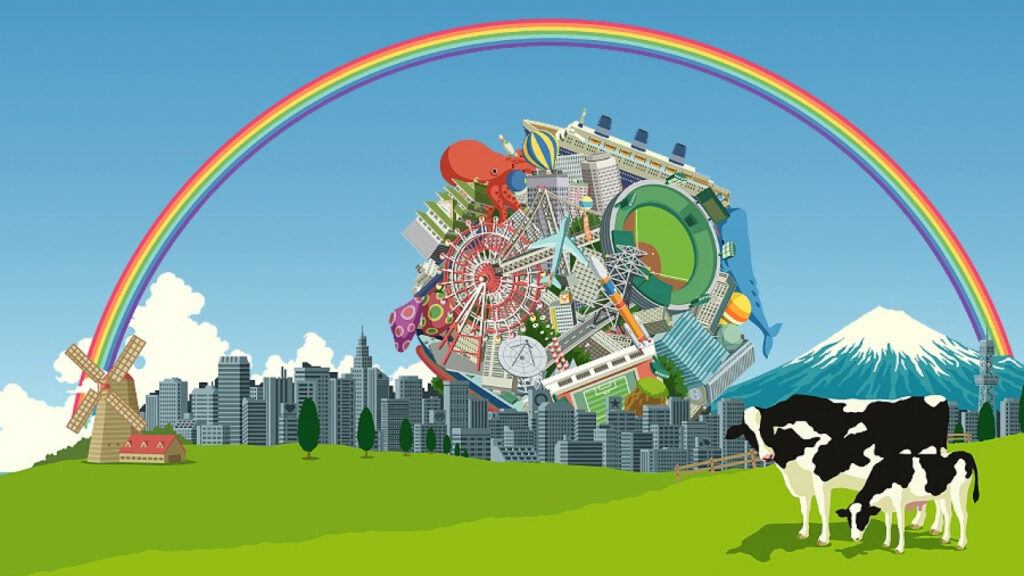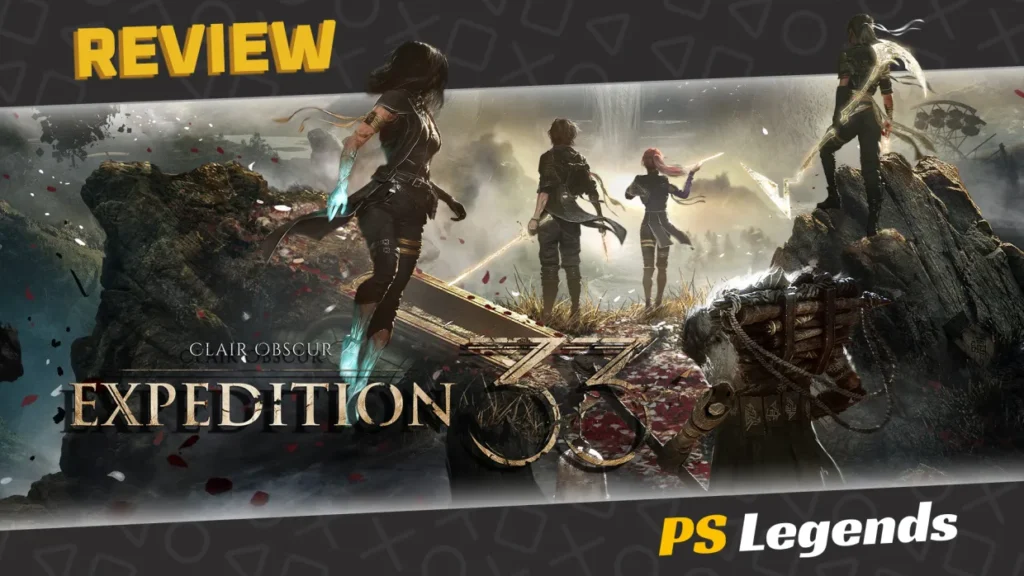In an ocean of classic and well remembered titles like the PS2’s library sometimes it’s hard to pick out specific examples of what made the console stand out. Other times it jumps right to the front of your mind almost immediately. This is one of those times, because when I think “best games on the PS2” I never fail to think of one game series: The Katamari games. Now today I’m only going to be talking about the very first title, Katamari Damacy, but nonetheless would like to drive home just how incredible this title is both as the first game in its series and as one of the most cosmically fun PS2 titles in the entire library.
On This Page
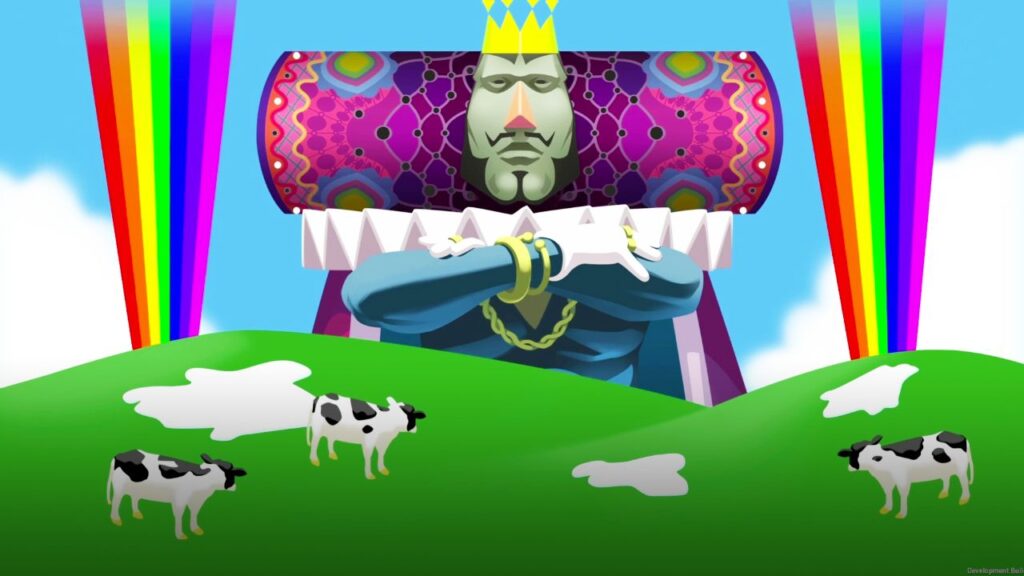
Visuals
Where do I even begin? Katamari Damacy boasts one of the most endearing art styles to date. With a gorgeously wacky intro video featuring a bizarre cast of characters and scenes to its endlessly charming low-poly models and bright popping colors. It’s an understatement to say that the game’s visuals were built to last. Objects and environments in the game are mostly based on modern (at the time) everyday objects and locals from Japan. Some interesting trivia on the timeless art style is that it was created due to the maker of Katamari, one Keita Takahashi, was suggested by his former boss, Mitsutoshi Ozaki, to approach a senior class of the Konami Computer Entertainment School who at the time was being trained on 3D modeling for possible game prototypes with other Namco employees. Takahashi approached the class about creating the multitude of 3D objects and models needed to populate the wonderful world within the game, ultimately resulting in the charming art style we’ve come to appreciate the series for. I really can’t understate just how well the visuals have held up for how simplistic they are. Without much else to say, they’re a staple of the series for a very good reason.
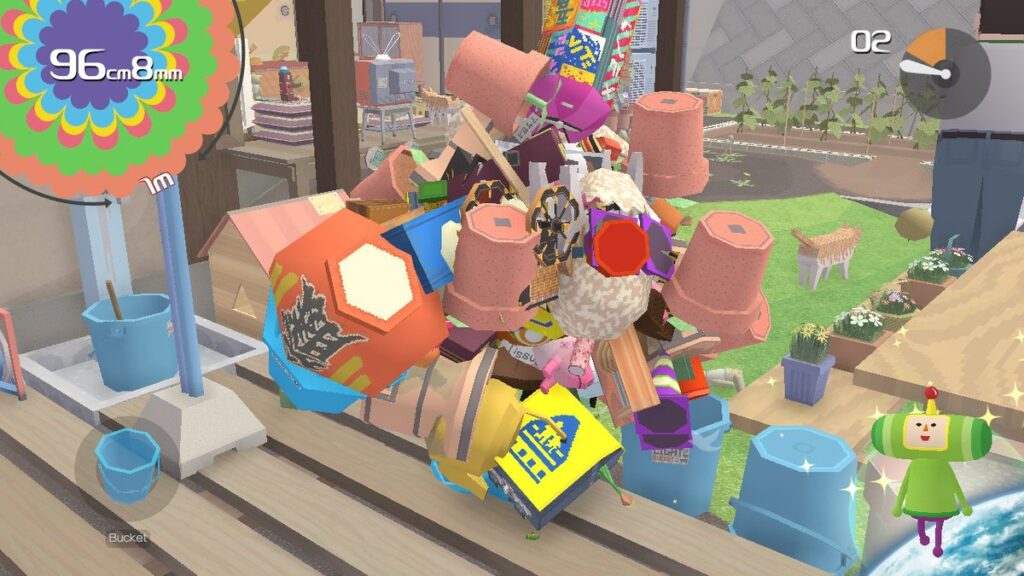
Level design
What could easily be considered the real meat of the Katamari experience is its delightfully designed levels. From a cluttered living room to a scaled down version of the entire world, there’s no shortage of fun to be had within the level design itself. Levels range from smaller scale and cluttered for the smaller rolling goals, to large open spaces that may even have their objects replaced via a loading screen halfway through. Levels are well made with large stretches packed with clutter (and often people/animals) and small vertical climbs/ramps for some more puzzling rolls. The game’s very first proper stage, Make a star 1, takes place inside that cramped living room I mentioned later. However, the size of the room is no object when it comes to just how packed it can get with objects to add to your ever growing rolling cluster.
Between being able to roll on, over, and under the kotatsu in the center of the room, the floor is positively littered with tiny objects such as coins, buttons, and batteries, and taller places like the couch and cupboards to roll across, the room has does a stellar job of being an introduction to the addictive gameplay loop of rolling. On top of this tight level design are the special levels, the constellations, which range from freeform fun to sometimes maddening precision. These stages are centered around collecting particular things to make specific constellations. Take Signus for example. That stage has you rolling up swan eggs in the backyard map, however, the eggs look exactly the same as every other type of egg in the stage. This includes chickens, crabs, fake plastic eggs, and some others that might trip you up, encouraging the player to make a mad dash to collect as many eggs as possible to maximize the number of swans you collect.
On the opposite end of the scale are the infamous cow and bear stages, taurus and ursa major respectively. But what’s so different? These stages are designed to test your rolling skills on an entirely different level. The goal of these two stages is to roll up only the single largest cow or bear. That being said, the maps these take place in are not only littered with clutter to improve the size of your Katamari, but also with cows and bears of far inferior size to what you’d need to get a good score. Meaning if you want to do well you have to bring your absolute best. Rolling into a single cow/bear item will end the stage instantly and stick you with whatever score that item would give you, unless you retry of course. It’s this fine tuning and pure focus on fun that makes the level design so freeing in a game that already feels fast and loose in the best way possible.
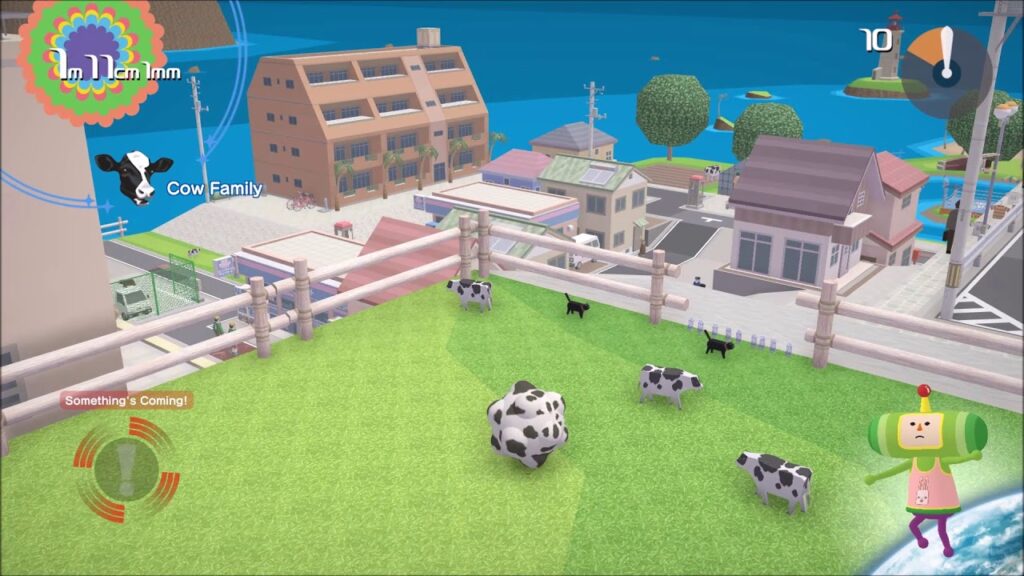
Gameplay
Here’s where the game can sometimes show some of its rougher edges. While most of the game is very smooth sailing, rolling around collecting to your heart’s content, it’s during these sessions of rolling action that you can sometimes get tripped up. The game’s control scheme, for example, is sometimes considered a bit clunky by modern standards. While I personally enjoy the feeling it provides of rolling your Katamari around just like the little prince you play as, it’s definitely unorthodox. To move you press both thumbsticks on the DualShock together in tandem as if they were your hands. This doesn’t seem too complicated until you need to alternate them to turn, or shake them back and forth for a boost. It’s not terrible, but can certainly feel like it results in some unpleasant navigation around areas that aren’t just straightaways.
Along with this are some of the game’s traversal mechanics themselves. In particular, climbing has never worked well for me. You’re supposed to be able to gently run your Katamari into shorter walls and sloped surfaces and have it magically stick and roll its way up. Useful, right? It would be if the game’s collision system didn’t register some objects hitting the walls as a full speed slam, making the object fly off with other smaller ones and your Katamari go spiraling away from the wall.
At worst it’s frustrating, but at best it’s a relatively smooth experience that sends you rolling and climbing over everything in your path to collect as much as physically possible. Everything else I could say about the core gameplay is to put it simply, unabashedly fun. With such a simple loop of roll, collect, repeat, it’s very hard to mess up. Even with the aforementioned hiccups the game provides such a solidly simple foundation that they come more as unpleasant bumps in an otherwise flawless road.
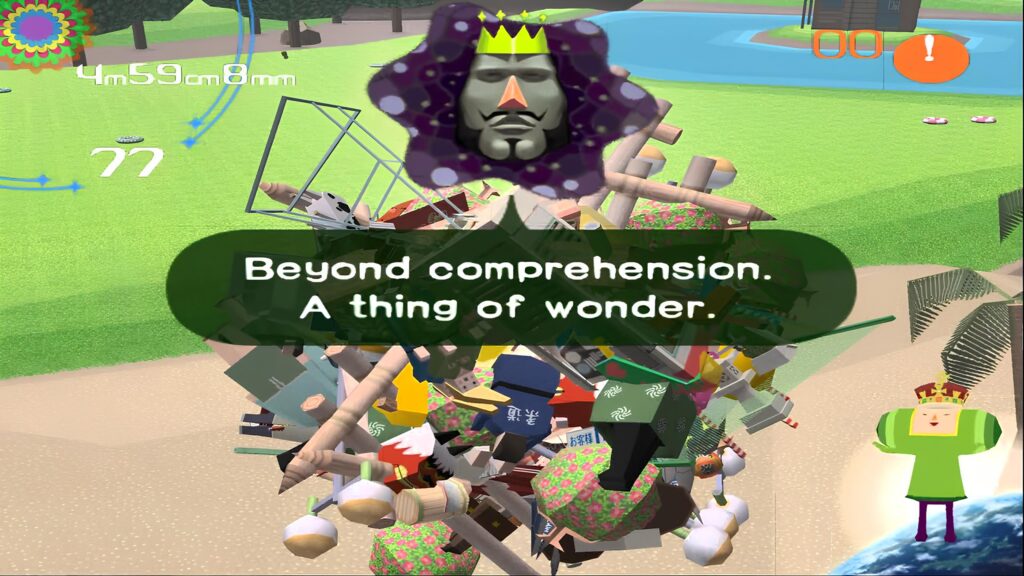
Story
The shortest part of this review by far. Katamari’s story was never its focus. The game was made more to put emphasis on the joy and fun of playing it rather than any sort of gripping narrative. But as the simplistic story goes, your character (The prince of all cosmos) is the son of the strange and rather pompous King of all cosmos. Some time ago the king went on a bit of a bender where he destroyed all the stars in the sky for fun. Brushing right past how horrifying that has the potential to be, you’ve now been tasked with collecting items from Earth with your Katamari to throw up into the sky and replace the lost stars. Meanwhile on Earth, the Hoshino family follows a loose narrative of going to see the father of the family, an astronaut, blast off before the launch is canceled due to the sudden lack of stars. There’s not much else to the tale, unfortunately. You as the prince make your way through the game and replace all the stars, and celebrations ensue. Like I said before, it’s simple, serviceable, and an overall perfectly harmless narrative in a game that really didn’t need one.
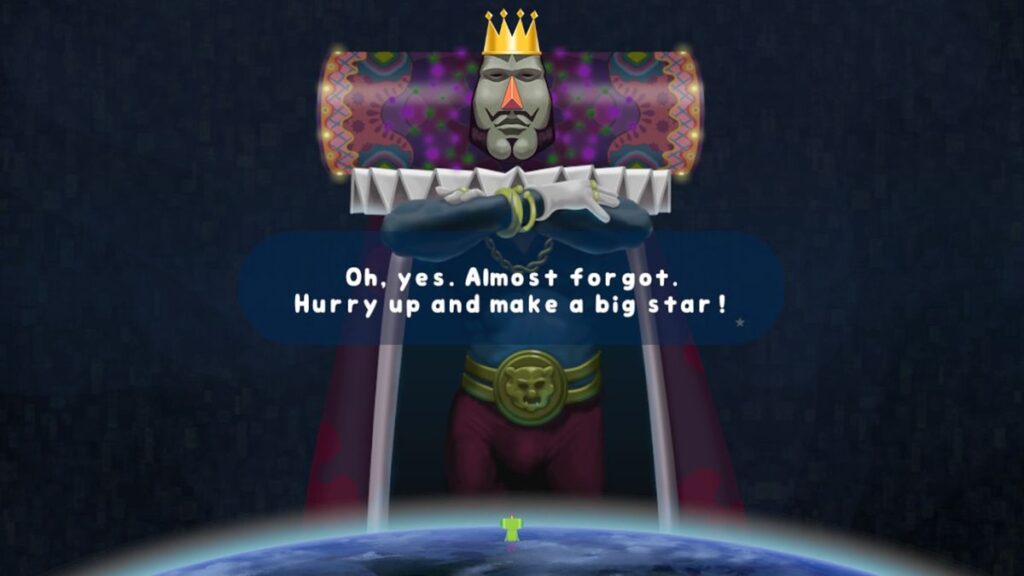
Soundtrack
One cannot simply make a review of Katamari Damacy without dedicating an entire segment to the absolutely stupendous soundtrack. Wildly praised for being inventive and imaginative within the genre of video game OSTs, it’s stood the test of time better than just about anything else from the game. Most of its tracks were composed by the now legendary Yuu Miyake better known at the time for his work on the Tekken and Ridge Racer series, as well as featuring vocal performances from then-popular J-Pop stars such as Yui Asaka and prominent anime voice actors including Nobue Matsubara and Ado Mizumori. One track was even composed by Charlie Kosei of Lupin III fame. Much like the visual portion of this review it really cannot be understated just how stellar the soundtrack is. The game’s official theme, Katamari on the Rocks, reverberates from the very start with bombastic horns and chorus lines to punctuate the fantastically overstimulating opening. The game’s unofficial theme however, Lonely Rolling Star written by Yoshihito Yano, composed by Yuu Miyake, with vocals by Saki Kabata, has gone on to be one of if not the most popular pieces of music from the score. And for a very, very good reason. With a mix of electronic “video-gamey” sounding tracks and jazz ranging from smooth to wild, the music of Katamari Damacy stands as a testament to its place as a work of art among the best of the best on the PS2. The soundtrack would go on to win both IGN and Gamespot’s “Best soundtrack of 2004” award. It also saw a release as a standalone album sparking a trend that would follow well into its sequels. It’s incredibly plain to see just how passionate and vibrant the compositions are in tandem with the game’s endless charm.
Conclusion and comments
Katamari Damacy isn’t a cult classic, and it certainly isn’t an underrated gem. It’s seen praise for years and years, spawning several sequel games and a full remaster/rerelease on all platforms in 2018 as Katamari Damacy Reroll. What Katamari Damacy is, is a work of art. An epitome of what video games should all strive to be at their core, fun. Endlessly charming, nearly infinitely replayable, and only topped by it’s the very next game in its long lineage of delightfully weird fun. But that’s a story for another time. This game stands tall among the other giants of the PS2’s already fantastic library and is a surefire addition to any collection looking for the best and brightest on the system.
Joys
- Unbelievably good soundtrack
- Delightfully timeless art style
- Simple and fun gameplay loop
Cons
- Clunky controls at times
- Small gameplay hiccups/glitches
